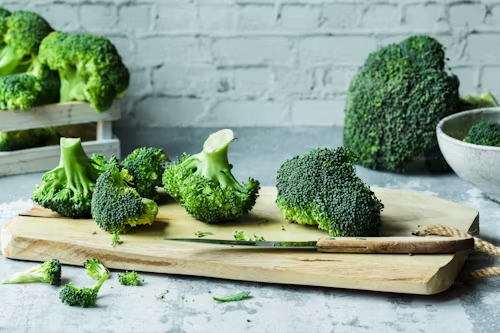A Comprehensive Guide
Broccoli is a plant in the cabbage family and is highly nutritious as it is rich in vitamins, fiber and antioxidants. This green vegetable is a very good source of nutrients and a true superstar when it comes to the food pyramid. As a seasoned chef, health-oriented individual or someone who intends to incorporate more greens into their diet, it is vital to grasp serving sizes. If so, in case you have been wondering how many cups is six servings of broccoli or looking for the answer to the same question or thinking that there could be and there must be an answer provided to you. Then let me say- yes. This guide will provide you with almost everything- tips on how you can measure, prepare and utilize this green vegetable that is loved all over the world.
Understanding Broccoli Serving Sizes: The Basics
Before we dive into the specifics of 6 servings, let’s clarify what constitutes a single serving of broccoli. According to dietary guidelines, a standard serving of broccoli is:
- ½ cup of cooked broccoli: This applies to both florets and chopped stalks.
- 1 cup of raw broccoli: Because raw broccoli is less dense, a larger volume is considered a single serving.
Keep in mind that these are only recommendations. Age, degree of activity, and nutritional objectives are few examples of variables that may affect an individual’s demands.
Calculating 6 Servings of Broccoli: The Answer You’ve Been Waiting For
Answering to What has been a Question of numerous people without Response- How many cups of broccoli is Six Servings?
- Cooked Broccoli: 6 servings x ½ cup/serving = 3 cups of cooked broccoli.
- Raw Broccoli: 6 servings x 1 cup/serving = 6 cups of raw broccoli.
Therefore, if your recipe calls for 6 servings of broccoli, you’ll need 3 cups of cooked broccoli or 6 cups of raw broccoli.
Measuring Broccoli Accurately: Tips and Tricks
Accurate measurement is essential for both nutritional tracking and recipe success. Here are some helpful tips:
- Use Standard Measuring Cups: Invest in a set of standard dry and liquid measuring cups for accurate results.
- Chop Broccoli Evenly: For cooked broccoli, ensure the florets are roughly the same size for even cooking and accurate measurement. For raw broccoli, chop the stalks into uniform pieces.
- Pack Lightly for Raw Broccoli: When measuring raw broccoli, don’t pack it tightly into the measuring cup. A light, loose fill will give you a more accurate measurement.
- Measure After Cooking: If your recipe calls for a specific amount of cooked broccoli, it’s best to measure after cooking, as broccoli reduces in volume when cooked.
Preparing Broccoli: Delicious and Nutritious Options
Broccoli is incredibly versatile and can be prepared in countless ways. Here are a few popular methods:
- Steaming: Steaming preserves the most nutrients and results in tender-crisp broccoli.
- Roasting: Roasting brings out the natural sweetness of broccoli and creates a slightly crispy texture.
- Sautéing: Sautéing is a quick and easy way to cook broccoli with a bit of oil or butter.
- Blanching: Blanching is the process of briefly boiling broccoli and then stopping the cooking process by submerging it in freezing water. This method helps retain the vibrant green color and crisp texture.
- Raw: Raw broccoli can be enjoyed in salads, dips, or as a crunchy snack.
Nutritional Benefits of Broccoli: A Nutritional Powerhouse
A nutrient-dense superfood, broccoli has several health advantages:
- Rich in Vitamins and Minerals: Broccoli is an excellent source of vitamin C, vitamin K, vitamin A, folate, and potassium.
- High in Fiber: Broccoli is a good source of dietary fiber, which promotes digestive health and helps regulate blood sugar levels.
- Antioxidant Powerhouse: Broccoli contains powerful antioxidants that help protect cells from damage.
- Potential Cancer-Fighting Properties: Some studies suggest that compounds in broccoli may have cancer-preventive effects.
Incorporating Broccoli into Your Diet: Delicious and Easy Ideas
Here are some delicious and easy ways to incorporate broccoli into your meals:
- Roasted Broccoli with Garlic and Lemon: Toss broccoli florets with olive oil, garlic, lemon juice, and salt, then roast until tender-crisp.
- Steamed Broccoli with Cheese Sauce: Steam broccoli and top with your favorite cheese sauce.
- Broccoli Salad: Combine raw broccoli florets with other vegetables, nuts, and a creamy dressing.
- Broccoli Stir-Fry: Stir-fry broccoli with other vegetables and your favorite sauce.
- Broccoli Soup: Blend cooked broccoli into a creamy and comforting soup.
Common Questions About Broccoli and Serving Sizes:
- Does the size of the broccoli florets matter? While it’s best to chop florets relatively evenly, slight variations in size won’t significantly impact the overall measurement.
- Can I use frozen broccoli? Yes, frozen broccoli can be used interchangeably with fresh broccoli. Just be sure to thaw and drain it before measuring.
- Does the cooking method affect the serving size? Cooking broccoli will reduce its volume, so it’s important to measure after cooking if your recipe calls for a specific amount of cooked broccoli.
Conclusion: Embrace the Broccoli and Enjoy its Benefits
To control the portion of food you eat and to also provide the correct quantity of food to already cooked recipes, it is essential to understand the concept of serving sizes. After reading this article, whether you want raw or cooked broccoli, you now certainly know the number of grams equals 6 servings. So then I fully like the Broccoli, because it’s tasty, it’s healthy, and most importantly, it’ll get you so many benefits.



